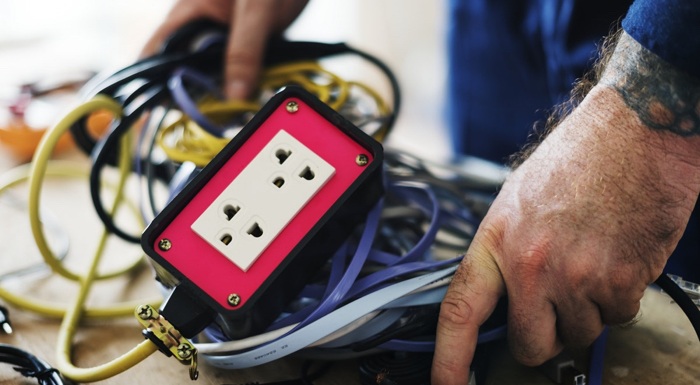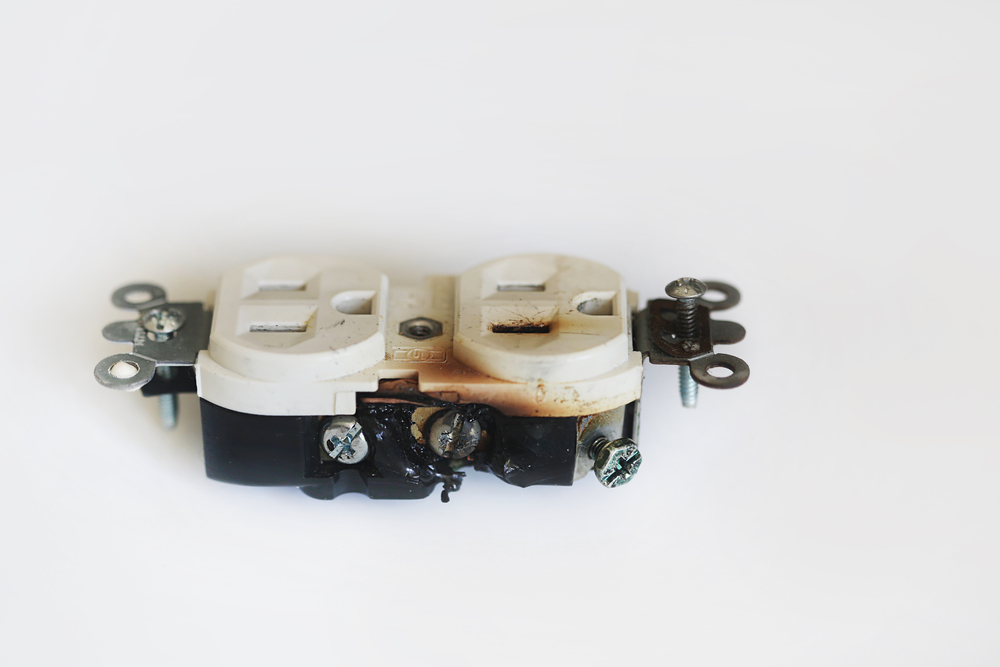Easy In-House Electrical Inspection – Damaged Electrical Outlets
Found a melted or scorched electrical outlet? Be glad — it could have been a lot worse. Outlets burn and melt due to internal sparking or overheated wires. Left unfixed, you could end up with a house fire, broken appliance, or severe injury. Many homeowners can confidently replace an electrical outlet as a DIY project, but in this case you may have wiring damage that requires professional repair. Get in touch with us about replacing and testing your electrical outlets to make sure power flows smoothly.
Sparks Are Flying
When all the parts are tight and in good condition, power flows normally through the electrical outlet. If a metal part becomes loose or damaged, the power jumps around in sparks. This is called arcing.
The most common example: the screw that holds the wire onto the terminal might be loose. When power flows through that wire, some of the energy shoots a spark toward the metal receptacle box or another metal part.
Arcing can cause a fire, but it more often overheats the electrical outlet. Plastic cannot withstand the heat, and begins to melt. You may notice black or brown burn marks before the plastic actually melts.
Insufficient Wiring
Wiring problems can also cause a melted electrical outlet. Whenever there’s more power than the wires can handle, overheating happens. Either the wires were not the correct size to begin with, or you have an electrical system problem sending excess power to the receptacle.
If you have performed some DIY repairs on the electrical outlet or perhaps the previous homeowner might have done something amateurish, it’s best to bring in a professional electrician to make sure the wiring is safe — especially after verifying that the terminals are tightly screwed on and everything looks good otherwise.
Don’t Ignore Smaller Problems
It’s hard to ignore sparks and melting plastic, but many people ignore problems like a loose electrical outlet, flickering lights, and frequently tripping breakers. Remember: breakers trip because something is wrong. And healthy outlets always work reliably. Take these issues as warning signs of a bigger problem!
If one electrical outlet melts, check the other outlets in the room for damage. You may have a problem beyond the one outlet, especially if faulty wiring is to blame.

What does a home electrical system inspection involve?
electrical inspectors must examine several segments of your home’s electrical system, including:
- Service panels and subpanels (what some people may call a circuit breaker or fuse box):
- They’ll typically remove the cover, noting that nothing inside the panel is humming or hot—and that there are no fuses instead of circuit breakers. They’ll also check for loose wires, that wires are the right gauge for the breakers, and that the main breaker is the right size. (Smaller than 100 amps is not enough for the electrical needs of a modern family, ICA says.)
- Outlets (or receptacles): They’ll use a handheld device, a multimeter, to probe the outlet and check the voltage and ground wire.
- Light switches and fixtures: They’ll take a representative number of installed lighting fixtures, receptacles, and switches.
- GFCI circuits and arc-fault circuit interrupters (AFCIs): The absence of GFCIs, AFCIs (which interrupt the circuit when it detects an electric arc), or other “overcurrent protection devices.”
- The type of wiring: such as aluminum, knob-and-tube, or copper, and whether any of it is exposed or loose.

Don’t Overload Your Home
According to the National Fire Protection Association, 47,700 home fires in the U.S. are caused by electrical failures or malfunctions each year. These fires result in 418 deaths, 1,570 injuries, and $1.4 billion in property damage. Overloaded electrical circuits are a major cause of residential fires. Help lower your risk of electrical fires by not overloading your electrical system.
Overloaded circuit warning signs:
- Flickering, blinking, or dimming lights
- Frequently tripped circuit breakers or blown fuses
- Warm or discolored wall plates
- Cracking, sizzling, or buzzing from receptacles
- Burning odor coming from receptacles or wall switches
- Mild shock or tingle from appliances, receptacles, or switches
How to prevent electrical overloads:
- Never use extension cords or multi-outlet converters for appliances
- All major appliances should be plugged directly into a wall receptacle outlet. Only plug one heat producing appliance into a receptacle outlet at a time
- A heavy reliance on extension cords is an indication that you have too few outlets to address your needs. Have a qualified electrician inspect your home and add new outlets
- Power strips only add additional outlets; they do not change the amount of power being received from the outlet

Common Electrical Problems Found During Home Inspections
Whenever a home is being sold, it’s a common (and smart) practice for a prospective buyer to hire a qualified home inspector. Home inspectors can not only help assess a home or buildings condition but identify potential problems that may be factored into the terms of a sale or purchase price. In some cases buyers also engage the services of a licensed electrician to check and identify any electrical problems that a regular home inspector might miss. The most common problems we have seen that result in failed home inspections include the below …
Extension Cords in Permanent Use
Extension cords are to be used on a temporary basis for an external or remote power supply. If somebody is using extension cords on an everyday basis, that can only mean one thing: There aren’t enough outlets to handle all of the electrical devices the home or building uses today. This is more common in older homes, but it is a safety concern and it should always be corrected prior to a sale.
Improperly Wired Switches
This is a common problem electricians find when doing an inspection. People who try to do their own wiring or hire somebody who has only rudimentary electrical skills will often use reverse polarity when wiring a switch or an outlet. This happens when hot and neutral wires get “flipped” around, and doing this creates a shock hazard.
Missing or Faulty GFI Outlets
Faulty GFIs are a major issue even in newer homes in the Las Vegas / Henderson area due to the common use of cheap > lower quality materials. GFI (short for ground fault interrupter) outlets are what’s required wherever an electrical outlet is close to a source of water (like in a bathroom). The indicator of GFI failure is when they prematurely or frequently ‘trip’ resulting in the loss of power to localized electrical components (lights or other power supplies on the same circuit). GFI replacement is a relatively quick fix for a licensed electrician, and with higher quality components will result in several years of reliable use. It’s essential that GFIs are kept in good working order as their function is to protect you from the possibility of electrocution.
Double-Tapped / Lugged Breakers
This is when multiple wires are attached to a single breaker – a dangerous practice. As most circuit breakers are designed for single wires, this can cause loose connections, arcing, and potentially a fire. This is typically corrected by either the addition of additional breakers or in some cases where there are not load concerns, by wire nutting the connections together prior to the breaker panel.
Ungrounded Receptacles
It’s not unusual to find ungrounded electrical receptacles, especially in older homes. You can easily check if your own home’s outlets are grounded or not. Ungrounded outlets just have two slots to plug into, whereas grounded outlets have two slots plus a hole for the ground wire. It’s a good idea to have ungrounded receptacles upgraded to minimize risk of fire in the event that there is ever a fault with the electrical component using the circuit.
Understanding Electrical Inspection
What is the difference between a rough and a final inspection? There are at least two stages at which you’ll need to undergo electrical inspection and approval, usually by the same body that issued your permit. Rough inspection is first, when installation of the electric box and all wiring is finished but before the wiring’s been covered by your wall material. Next is final inspection, when all your home construction has been completed. NOTE: Your electrical system must pass final inspection before occupancy is permitted.
Which areas does the inspection cover? Guidelines specifying the electrical inspection criteria for your location may be obtained at the time you apply for your permit. The basic areas are:
- equipment listing and labeling
- electrical services
- general circuitry
- AFCI (arc-fault) protection
- GFCI (ground fault) protection
- grounding and bonding
- underground wiring
- wiring methods.
Be aware that if the inspector is called in to inspect a specific upgrade, he may notice — and write up — a violation in other, already existing work.
What to do if your electrical system fails inspection? Details vary, depending on your locale. However, the basic procedure is this: If inspection reveals a problem, you or your electrician will need to correct it and have the system inspected again. There might or might not be a fee for re-inspection. In some regions, a third party performs re-inspection. Generally you don’t need a new permit to make corrections, which are considered part of the original work. If you disagree with the rationale for the failure (and the correction is time-consuming and expensive), you may be able to appeal.